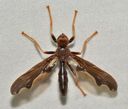Pyrgotidae
Pyrgotidae
Classification
- Phylum: Arthropoda
- Subphylum: Hexapoda
- Class: Insecta
- Order: Diptera
- Superfamily: Tephritoidea
- Family: Pyrgotidae
Pronunciation
How to pronounce Pyrgotidae: //pɪərˈɡɒtɪˌdiː//
These audio files are automatically generated. While they are not always 100% accurate, they are a good starting point.
Images






Summary
The Pyrgotidae are a unique family of flies distinguished by their lack of ocelli and endoparasitoid lifestyle, specifically targeting scarab beetles for reproduction.
Physical Characteristics
Brown patterning on the wings; typically 'picture-winged' with bands or spots on the wings.
Identification Tips
Head pattern of Sphecomyiella is generally darker, extending to the top of the head, while Boreothrinax has a lighter pattern that only reaches the middle of the frons.
Habitat
Usually found at lights, primarily in areas where their host beetles are abundant.
Distribution
Reported in various regions, particularly in areas where adult Scarab beetles are present.
Diet
Larvae are internal parasites of adult Scarab beetles, feeding on their host.
Life Cycle
Females lay eggs on beetles' backs; larvae enter the body cavity, where they develop, ultimately killing the beetle in about two weeks.
Reproduction
The female fly inserts eggs into the abdomen of the beetle while both are in flight, typically at night.
Ecosystem Role
Endoparasitoids of adult Scarab beetles, playing a role in controlling beetle populations.
Collecting Methods
- Light traps
- Netting during nocturnal activity
Preservation Methods
- Ethanol preservation
- Drying specimens
Evolution
Pyrgotidae represent one of two families of Cyclorrhapha that lack ocelli, exhibiting unique evolutionary adaptations among tephritoids.
Similar Taxa
Misconceptions
Often mistaken for other dipterans due to similar appearance and behavior.
Tags
- Diptera
- Pyrgotidae
- Cyclorrhapha
- Endoparasitoids
- Insects